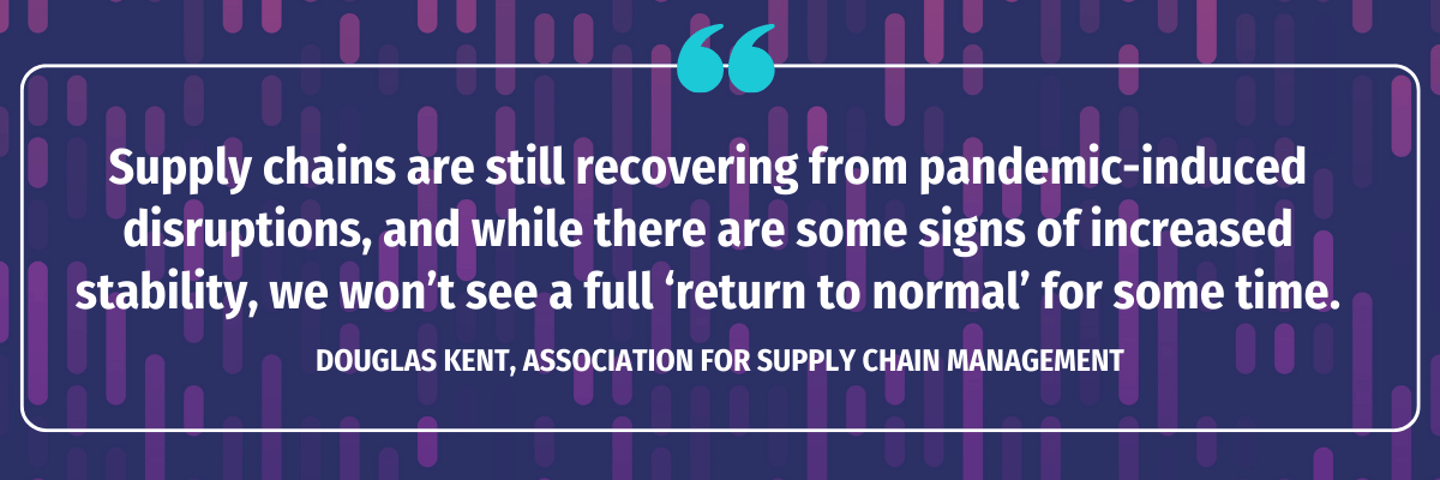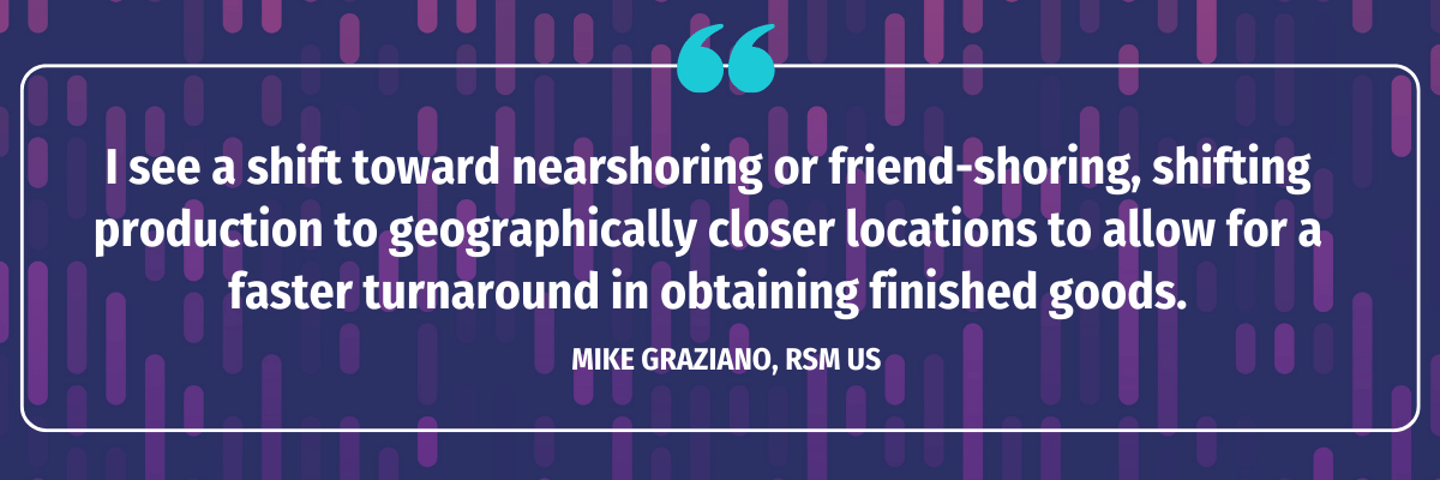Current Trends in Supply Chain Management
If there’s one consistent thing about consumer goods supply chain technology trends, it’s that change comes fast and furious. From pandemic-induced struggles like delays and rising costs, to consumer demands that shift at the speed of light, today’s consumer products companies need to be prepared for anything and everything.
What are the key trends impacting global supply chains in 2023?
A major key trend is the shift from supply side challenges to the demand side, says Adheer Bahulkar, managing director and global supply chain leader for consumer goods at Accenture.
With the commodity market improving, raw materials and global transportation obstacles have lessened. With rising inflation, however, consumers’ demand for products is decreasing, says Bahulkar
“On average, 66% of consumers are concerned about the economy over the next six months, and that’s directly impacting discretionary purposes,’’ he says. “Supply chain challenges are manifested in the sense that we now have a lot of volatility and predictability on the demand side, and the big question becomes, how much do we produce?”
In order to prepare for this shift, CPG brands will need to rethink their production planning and invest in the tools needed to improve efficiencies, including intelligent and hyper-automation, sustainability practices, open configuration platforms, and more.
Are supply chains improving 2023?
While things aren’t as dire as they were during the thick of the pandemic, it’s not all sunshine and roses just yet (nor will it ever be). Normal is unlikely to be one of the top supply chain trends in the near future, and it’s expected that supply chain news will continue to be top of mind for many.
“Supply chains are still recovering from pandemic-induced disruptions, and while there are some signs of increased stability, we won’t see a full ‘return to normal’ for some time,” says Douglas Kent, EVP of strategy and alliances, Association for Supply Chain Management (ASCM). “There are still a variety of disruptions occurring — this year alone, we’ve seen increased cyberattacks, labor shutdowns, and adverse climate events such as the wildfires in Quebec and Maui and the drought in the Panama Canal.”
“Additionally, as the U.S. focuses on nearshoring and boosting domestic manufacturing, we need to make sure we have the talent available to support those added efforts, or else we risk more delays and heightened instability,” he adds.
Consumer products companies looking to get ahead despite the rocky environment are investing in transformative tools and technologies, including artificial intelligence. Garrett Brands LLC., for example, which is known for brands like Garrett Popcorn Shops and Frango Chocolate, is tapping a suite of AI-based supply chain planning tools to overhaul demand forecasting and planning, replenishment, and inventory optimization. By using a built-in probabilistic forecast, the company will be able to better respond to market uncertainty as it relates to inventory demand.
What is causing supply chain issues?
The only thing constant in life is change, and this platitude is particularly true for the CPG industry, which is constantly facing new obstacles in the daily challenges of supply chain management.
“Manufacturers are constantly dealing with the ripple effects of supply chain disruptions such as geopolitical conflicts, severe weather challenges, and uncertainty over trade policies. For example, proposed tariffs on tin mill steel stand to drive up the price of canned food and aerosol products from 19-30% if imposed due to the resulting sourcing difficulties that would be created for producers of canned goods,” says Tom Madrecki, VP of supply chain at Consumer Brands Association.
The murkiness of consumer demand for the 2023’s holiday peak season is also throwing a wrench into supply chain issues today. According to FourKites data, there was a 28% reduction year-over-year in home decor-related shipments in June, a month they cite as the typical beginning of holiday season shipping.
“Many manufacturers have opted to reallocate capital expenditures to network development projects (such as reshoring), reducing their investment in new inventory purchases,” says Tom Gregorchik, FourKites’ VP of industry strategy. “While inventory levels have recovered following 2021-2022’s supply chain crisis, if consumer demand is higher than anticipated, there could be issues with fulfillment.”
What’s more, while reshoring and nearshoring is meant to de-risk supply chains, he says, it’s expected to add new stress to North American logistics networks. “While Class-I railroads have worked hard to improve connectivity between MEX-USA-CAN, it still hasn’t experienced the surge in volumes that are bound to come with heightened manufacturing output in North America.”
So what can CPG companies do? For one thing, Madrecki advises it would help to focus on averting policies that just make things worse — e.g., policies that make it harder for the supply chain to operate seamlessly and inhibit the ability to meet consumer demand “on top of so many existing challenges beyond all control.”
What are the raw materials shortages in 2023?
Raw materials aren’t in as short a supply as they were a few years ago, according to some experts, easing one of the global supply chain challenges.
“There are fewer raw materials shortages than there used to be,’’ says Joe Beal, CEO and co-founder of supply chain technology provider Alloy.ai. “For a long time, we were getting lots of questions about allocation, about which retailer should receive limited inventory. We're not hearing that nearly as much anymore.”
The biggest material shortage is minerals, according to ABI Research’s Luitel. This is an especially big problem for electronics, which rely on copper more than anything, he says. Copper is “experiencing record lows this year,’’ he says, noting that copper production is done mostly in China and Africa. China still has a range of lockdowns, so there is a blend of high demand and mining sites not being as efficient as they used to be.
“We have not seen significant raw material shortages that affect the technology and semiconductor industries in the U.S. in 2023,’’ agrees Paul Silverglate, vice chair of Deloitte LLP and U.S. technology sector leader. “There were concerns about the war in Ukraine and supplies of ultrapure helium, utilized for semiconductor manufacturing, but those have not emerged, at least not yet.”
That said, he noted that China began placing restrictions on gallium and germanium, both of which are used in electronics, on Aug. 1. “The good news is that U.S. companies that rely on these materials already had about six-to-nine months of inventory, plus [they] had some time to further accumulate more in reserve on the open market before the restrictions went into effect,’’ he says.
John Harmon, senior analyst at Coresight Research, notes that there are currently some pockets of chip unavailability, “but the biggest challenge is that there is still significant excess inventory in the channel (particularly of PCs), which will take roughly the rest of this calendar year to be worked down.”
What are the future trends in supply chain management?
The future of supply chain is leaning heavily toward digitization, according to Adheer Bahulkar, managing director and global supply chain leader for consumer goods at Accenture, and Adhish Luitel, a senior analyst in ABI Research’s supply chain management and logistics division. Both stress the importance of end-to-end visibility across core supply chain components for near-time read and response.
The need to anticipate and prepare for all potential disruptions necessitates significant investment in data, and Luitel predicts real-time visibility becoming the de facto standard in the coming years. He also foresees CPG companies increasingly adopting electric vehicles for transportation.
IoT technology is expected to expand beyond warehouses to improve yard management and prevent loss of goods during transit. As part of this, Luitel points to the emerging use of ambient IoT, including energy-harnessing trackers that could be applied to items like milk gallons.
It’s also safe to bet that use of AI and automation will increase, with a particular focus on micro-fulfillment centers that will be built closer to consumers. These centers will feature advanced automated systems like massive retrieval systems and robotic arms for more efficient order picking and packing, according to Luitel.
“The future of supply chain management largely depends on the adoption of technologies in automation, IoT, AI and more in order to bring sustainability, visibility, and reliability to operations,” agrees Douglas Kent, EVP of strategy and alliances, Association for Supply Chain Management (ASCM). “The sooner companies realize that disruption is the new normal, the sooner they can focus on bolstering their risk management and digitization strategies, ultimately taking a more proactive — not reactive — approach to problems.”
Mike Graziano, consumer products senior analyst with RSM US, sees an increase in supply chain diversification in the CPG industry and more companies spreading manufacturing to multiple vendors.
“I also see a shift toward near-shoring or friend-shoring, shifting production to geographically closer locations to allow for a faster turnaround in obtaining finished goods,” he notes. “By transitioning a portion of supply chains from overseas to closer at home, you can reduce your lead times significantly and capitalize on ever-shifting consumer preferences.”
What are the predictions for 2025 supply chains?
We tapped a number of these experts for some CPG industry supply chain predictions. For his part, Bahulkar believes that the pace of change and the mandate that supply chains stay competitive means there will inevitably be winners and losers. “The bifurcation of winners and laggards is going to increase significantly, where we will see leaders really benefiting from their smart investments from their growing digital maturity.”
This will enable them to consolidate a lot more market share, while the laggards will find it increasingly difficult to continue to compete — or continue to compete profitably, he says.
Further, supply chains will become “the vehicle for growth” in consumer goods, Bahulkar believes. Accenture data increasingly indicates that “slowly, but surely, a very sizeable portion of consumers globally are beginning to make their buying decisions not on brand or even on price but based simply on speed and convenience,’’ he says. “That change in consumer behavior suddenly makes the supply chain a growth function.”
But the uncertainty of the past three years continues its stubborn hold and has resulted in a “general fatigue in the industry,’’ notes Beal. “Everyone wants a sense of normalcy, but it’s hard to know if that will ever come.
“Today, companies find the economy scary, but still fundamentally strong,’’ he says. “In 2025, I can see a world where things calm down, and where there is lots of optimism and investments. But I could also see the opposite happening, unfortunately. So much depends on the economy.”








